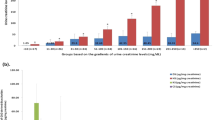Abstract
GINETZINSKY recently described a relationship between urinary hyaluronidase and urine concentration1. He found that urinary hyaluronidase assayed by his method was high at low urine volumes, virtually disappearing during water diuresis; but it remained high during an osmotic diuresis. From these results he inferred that antidiuretic hormone might act by stimulating the production of hyaluronidase within the nephron; this would facilitate water re-absorption by allowing water to pass through the ground substance between the cells. In an attempt to confirm Ginetzinsky's findings it became clear that his method2 is unsuitable for quantitative assay of urinary hyaluronidase for the following reasons : (1) Precise estimation of hyaluronidase by any viscosimetric method is dependent on a constant electrolyte composition of the hyaluronidase–hyaluronic acid system, as was demonstrated in 1940 by Madinaveitia and Quibell3, and by McLean and Hale4. Urine has a variable electrolytic composition, and as Ginetzinsky does not appear to make any correction for this, his results are not quantitative. (2) Ginetzinsky1 fails to express his results as hyaluronidase excreted per minute, relying solely on arbitrary units per ml. If hyaluronidase were excreted at a constant rate like creatinine, then a graph of its concentration against urine flow per minute would be similar to Ginetzinsky's Fig. 1. (3) He measures the initial viscosity of the mixture of urine, buffer and hyaluronic acid, the measurement being repeated after twenty minutes incubation, and the per cent reduction in viscosity is expressed as arbitrary units. This procedure is open to error as there is a rapid fall in viscosity before the initial reading5 if a high concentration of hyaluronidase is present.
This is a preview of subscription content, access via your institution
Access options
Subscribe to this journal
Receive 51 print issues and online access
$199.00 per year
only $3.90 per issue
Buy this article
- Purchase on Springer Link
- Instant access to full article PDF
Prices may be subject to local taxes which are calculated during checkout
Similar content being viewed by others
References
Ginetzinsky, A. G., Nature, 182, 1218 (1958).
Ginetzinsky, A. G. (personal communication).
Madinaveitia, J., and Quibell, T. H. H., Biochem. J., 34, 625 (1940).
McLean, D., and Hale, C. W., Biochem. J., 35, 169 (1941).
Dalgaard-Mikkelsen, S., and Kvorning, S. A., Acta Pharmacol., 4, 169 (1948).
Author information
Authors and Affiliations
Rights and permissions
About this article
Cite this article
BERLYNE, G. Urinary Hyaluronidase. Nature 185, 389–390 (1960). https://doi.org/10.1038/185389a0
Issue Date:
DOI: https://doi.org/10.1038/185389a0
This article is cited by
-
Relationship between Urinary Hyaluronidase and Diuresis
Nature (1961)
-
Antidiuretic Hormone and Renal Collecting Tubules
Nature (1961)
-
Relationship between Urinary Hyaluronidase and Diuresis
Nature (1961)
-
Electrolyte Excretion in the Cow, as Influenced by Variations in the Urine Flow
Acta Veterinaria Scandinavica (1960)
Comments
By submitting a comment you agree to abide by our Terms and Community Guidelines. If you find something abusive or that does not comply with our terms or guidelines please flag it as inappropriate.



